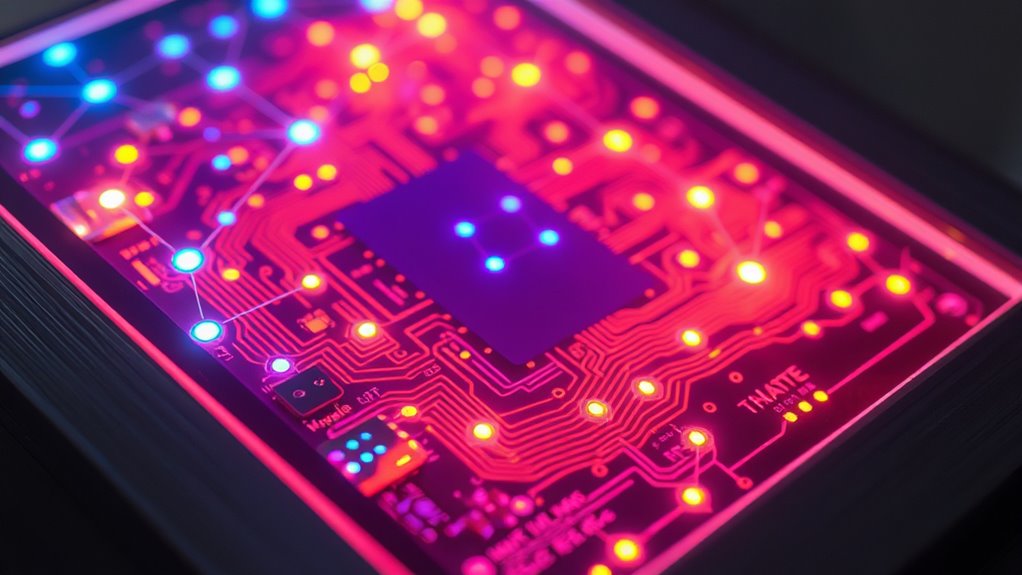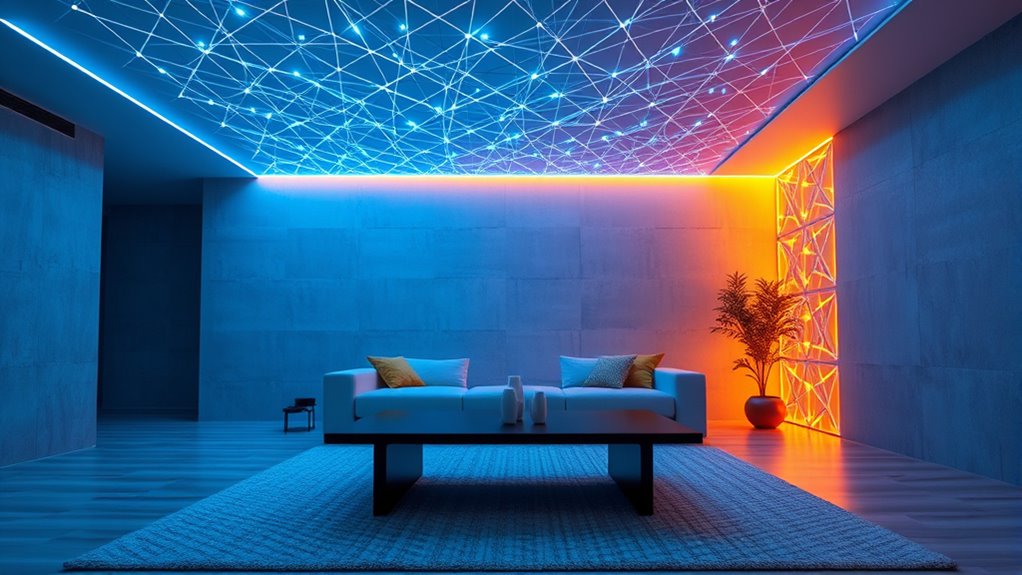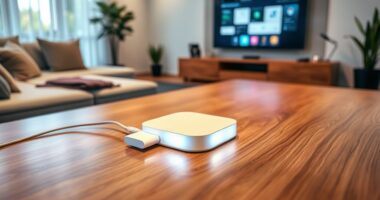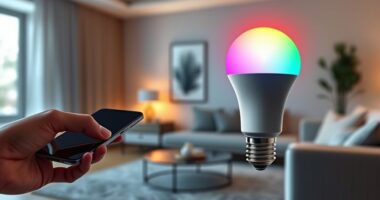Thread focuses on creating a low-power, reliable mesh network ideal for smart lighting and sensors, improving device connectivity and energy efficiency. Matter acts as a universal standard that bridges different protocols like Thread, Wi-Fi, and Ethernet, making smart home devices more compatible and easier to manage across brands. Together, they aim for seamless, secure, and efficient smart lighting solutions. Want to discover how these standards will shape your smart home’s future? Keep exploring.
Key Takeaways
- Thread is a low-power mesh protocol focused on device connectivity; Matter is a unifying standard ensuring cross-platform compatibility.
- Thread offers reliable, energy-efficient networks for smart devices, while Matter simplifies device setup and interoperability.
- Both standards complement each other, with Thread providing the network backbone and Matter enabling ecosystem integration.
- Future smart-home lighting will likely leverage Thread’s network resilience alongside Matter’s broad ecosystem support.
- The combined use of Thread and Matter promises more seamless, secure, and energy-efficient smart lighting solutions.

Have you ever wondered how Thread and Matter compare as blockchain solutions? While both aim to improve smart-home connectivity, they approach the challenge differently. Thread is a low-power, mesh networking protocol designed specifically for smart devices, emphasizing energy efficiency and reliable device communication. It allows your smart home gadgets to work seamlessly together, even if they’re from different brands. This focus on device interoperability ensures that your smart lighting, thermostats, and sensors can communicate smoothly without needing a central hub or complex setup. By supporting energy-efficient operation, Thread helps extend your device batteries’ life and reduces overall power consumption, making it ideal for battery-powered smart lighting. Its mesh network architecture means signals hop from device to device, creating a resilient and scalable network that adapts to your home’s layout. This setup minimizes latency and ensures your smart lights respond instantly, even if some devices are farther away from your router. Additionally, the fabric of connected devices is strengthened by Thread’s ability to support multiple devices in a single network, enhancing overall reliability.
In contrast, Matter acts as a unifying standard, aiming to bridge multiple protocols—including Thread, Wi-Fi, and Ethernet—under one umbrella. It’s designed to make smart-home devices more compatible across different ecosystems, such as Apple’s HomeKit, Google Home, and Amazon Alexa. When you choose Matter-compatible smart lighting, you gain the confidence that your devices will work reliably across various platforms, simplifying setup and reducing frustration. Matter emphasizes security and ease of use, which are essential for widespread adoption of smart lighting. It also promotes energy efficiency, encouraging manufacturers to develop devices that consume less power while maintaining high performance. With Matter, you benefit from a standardized approach that enhances device interoperability, allowing smart lights from different brands to sync effortlessly and respond uniformly to your commands.
While Thread’s strength lies in creating resilient, low-power networks tailored for battery-operated devices, Matter’s advantage is in unifying diverse ecosystems, making it easier to integrate smart lighting into your existing setup. If you prioritize energy efficiency and device interoperability within a mesh network, Thread offers a compelling choice. However, if you want a broader compatibility standard that simplifies managing multiple brands and protocols, Matter might be the future you’re looking for. Both are evolving, and many experts believe their combined use will shape the future of smart-home lighting standards, delivering smarter, more efficient, and more interconnected homes. Either way, understanding these differences helps you choose the right technology to create a truly seamless and energy-conscious smart lighting environment.
Frequently Asked Questions
How Do Thread and Matter Impact Energy Efficiency in Smart Lighting?
You might wonder how smart lighting impacts energy efficiency. Both Thread and Matter improve device interoperability, making it easier for you to control your lights seamlessly. With better integration, you can optimize energy consumption by scheduling or adjusting lights remotely. These standards guarantee your devices work together efficiently, reducing unnecessary energy use, and helping you save on electricity while maintaining a comfortable, connected home environment.
Are There Compatibility Issues Between Existing Smart Home Devices and New Standards?
Imagine a world like the Tower of Babel, where devices struggle to understand each other. Compatibility issues do exist between your existing smart home devices and new standards like Matter, but firmware updates can often bridge the gap. You might face initial hurdles, but manufacturers are working to improve device interoperability, guaranteeing your gadgets communicate smoothly as standards evolve. Staying updated with firmware ensures your devices stay compatible and future-proof.
What Security Protocols Do Thread and Matter Employ for Connected Lighting?
You should know that both Thread and Matter prioritize security through device authentication and encryption standards. They use robust encryption protocols to protect your connected lighting from unauthorized access and guarantee data privacy. Device authentication verifies that only trusted devices connect to your network, reducing security risks. These protocols work together to create a safer, more reliable smart home environment, giving you peace of mind with your lighting controls.
How Will These Standards Influence the Cost of Smart Lighting Products?
Sure, because nothing screams excitement like debating manufacturing costs and retail pricing. As these standards become mainstream, you’ll likely see reduced manufacturing costs thanks to streamlined production, which should lower retail prices. But beware: early adopters might still pay a premium for the latest tech. Ultimately, these standards aim to make smart lighting more affordable, so you can brighten your home without needing a second mortgage.
When Will Mainstream Adoption of Thread and Matter Become Widespread?
You’re wondering when mainstream adoption of Thread and Matter will become widespread. Market adoption depends on increasing consumer awareness, which influences demand for compatible smart home devices. As more brands support these standards and prices drop, you’ll see broader acceptance in the coming years. Typically, within 3 to 5 years, these standards will become more common in households, making your smart lighting more seamless, reliable, and easier to integrate.
Conclusion
As you stand at the crossroads of smart-home lighting, it’s like choosing between two shining stars—Thread and Matter. Thread acts like a dependable heartbeat, quietly powering your devices in harmony. Meanwhile, Matter is the rising sun, promising universal compatibility and brighter days ahead. Whichever path you take, know that your smart home’s future is a canvas waiting for your brushstrokes—bold, connected, and ready to light up your world.









